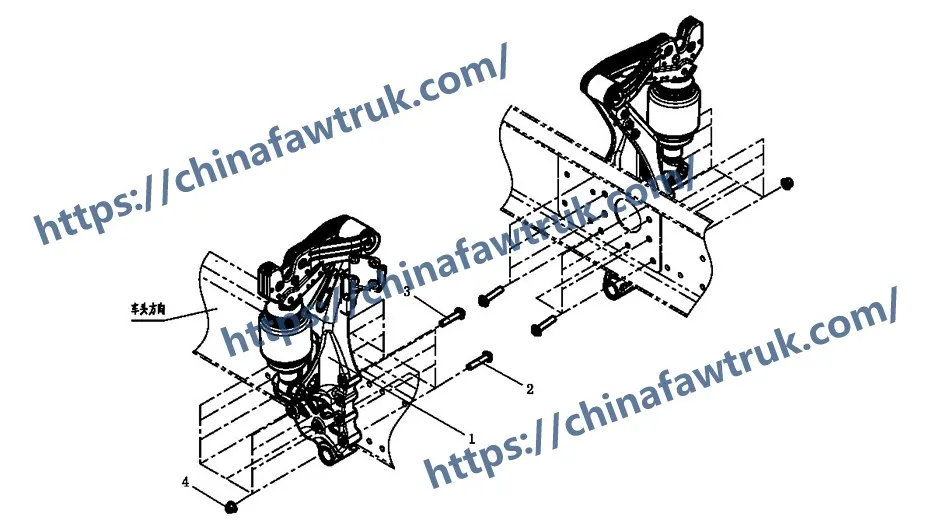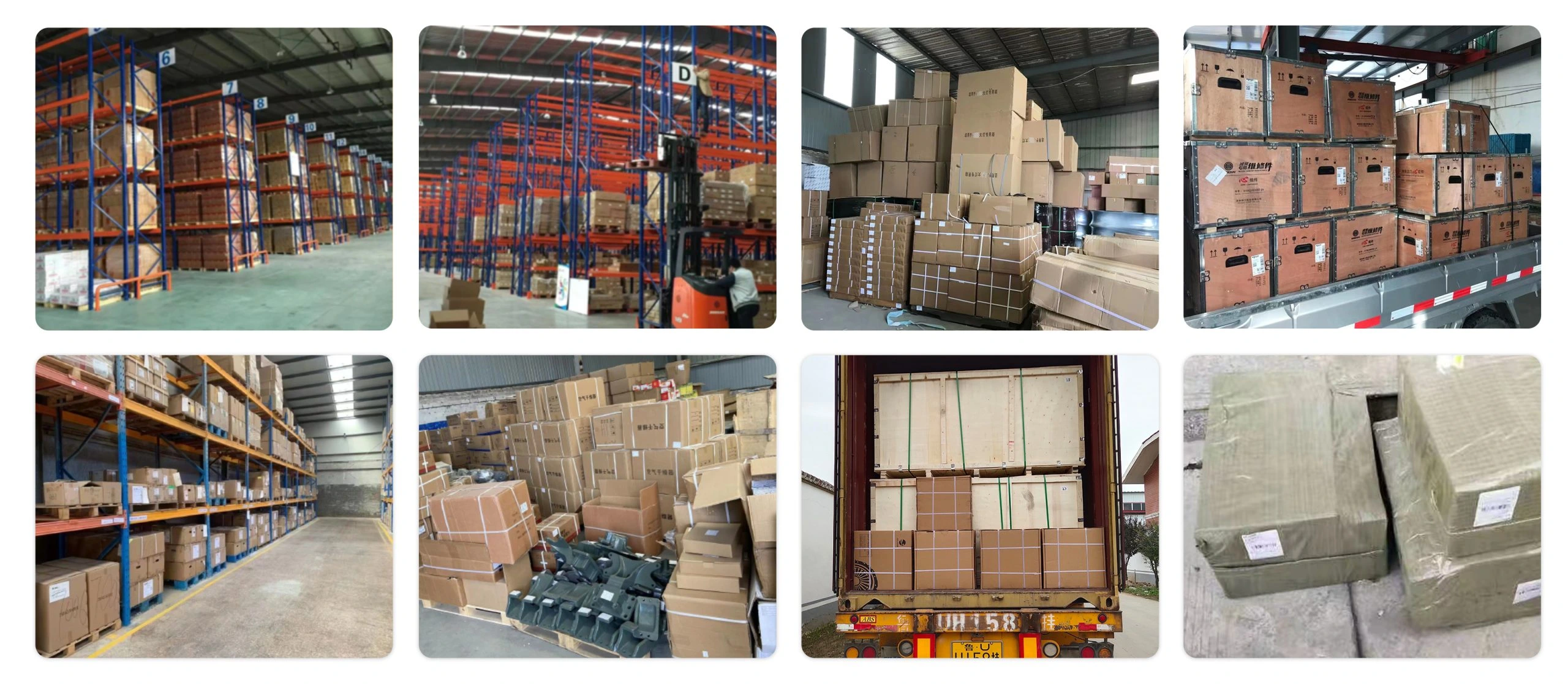

Welcome to this in-depth technical analysis of the FAW Rear Suspension Assembly For The Cab. This set of components is one of the most critical structural groups on the FAW Jiefang CA4251P66K24T1A3E5 6×4 diesel semi-trailer tractor. This is not just a simple mounting point; it is a highly-engineered “logic” assembly. Its core “logic” is to simultaneously perform two high-stress jobs: it serves as the rear anchor for the entire cab suspension system *and* the rear fixed mount for the chassis’s front leaf springs.

The FAW Rear Suspension Assembly For The Cab is the primary load-bearing interface connecting the driver’s cab to the truck’s chassis frame. The components detailed here (Part No. 5001280B91W) are responsible for handling massive longitudinal forces from the chassis suspension *and* vertical forces from the cab suspension (both air spring and coil spring types). This dual-function “logic” is a masterpiece of engineering, saving weight and frame space.
This expert guide is an essential resource for chassis technicians, fleet managers, and parts specialists. We will deconstruct the entire FAW Rear Suspension Assembly For The Cab into its 4 primary component types. We will analyze the “dual-logic” of the main structural bracket, and then break down the two different, high-tensile fastener groups that are critical for its safety and integrity.
This component is the “longer” and most substantial part of the FAW Rear Suspension Assembly For The Cab. The ‘Cab rear suspension & front steel plate spring rear fixed combined bracket assy’ (5001280B91W) is the primary structural MSU. The parts list calls for two (2), one for the left and one for the right chassis rail.
The “logic” of this “Combined Bracket” is its brilliant, space-saving, dual-function design. It performs two jobs that would normally require two separate, heavy brackets.
Function 1 Logic: Chassis Spring Mount
The first function is to serve as the *rear fixed mount* for the *chassis’s front leaf spring*. The front of the leaf spring attaches to a shackle that pivots. The rear of that same spring must attach to a fixed, non-moving point on the frame. This bracket is that point.
This means the bracket must be incredibly strong, as it handles all the longitudinal (fore-and-aft) forces of the front axle. All acceleration and braking forces from the front wheels are transferred through the leaf spring and into the chassis *through this single bracket*. This is why it is fabricated from heavy-gauge, high-tensile steel, designed to resist immense shearing and torsional stress.
Function 2 Logic: Cab Suspension Mount
The second function of the FAW Rear Suspension Assembly For The Cab is to serve as the primary mounting point for the *cab’s rear suspension*. This is the point where the rear cab air spring or coil-over-shock assembly mounts.
This part of the bracket’s “logic” is to handle the vertical (up-and-down) loads of the cab, isolating the driver’s environment from the chassis. By combining these two functions into one part, FAW engineers saved weight, reduced complexity, and saved valuable space on the chassis rail, all while increasing the overall rigidity of the frame at that junction.
Serviceability (MSU):
This “Combined Bracket” is a primary MSU. It is a non-repairable, safety-critical component. Failures are rare, but can be caused by severe collision damage or (if fasteners are loose) fatigue cracking from vibration. A damaged bracket must be replaced immediately, as a failure here would compromise both the chassis and cab suspension, leading to a loss of vehicle control.
The remaining three component types make up the critical fastening system for the FAW Rear Suspension Assembly For The Cab. This is not a simple collection of hardware; it is a precisely engineered “logic” system designed for clamping force and vibration resistance.
The system consists of 18 bolts and 18 nuts in total. This indicates a 9-bolt mounting pattern for *each* of the two main brackets.
The Fasteners:
This 1:1 ratio of 18 bolts to 18 nuts confirms that these are through-bolt connections, passing completely through the chassis frame rail.
The “logic” of this system is in the details.
Why Two Different Bolts (MSU 2 & 3)?
The FAW Rear Suspension Assembly For The Cab uses two different part numbers for its bolts (Q1851685T and Q1851695T). The “logic” here is simple: different grip lengths. The 10 bolts of the first type are likely for attaching the main body of the bracket to the flat web of the chassis frame. The 8 bolts of the second type are likely for the part of the bracket that mounts the spring eye, which may be thicker or require a different length bolt.
All of these are “flange” bolts. The flange is an integrated washer. This “logic” distributes the clamping force over a wider area, preventing the bolt head from damaging the bracket. It also makes assembly faster.
The “Flange Nut” Logic (MSU 4)
The ‘Hexagon flange nut’ (Q039716) is the most critical piece. These 18 nuts are also “flanged,” acting as a built-in washer on the nut side. More importantly, these are high-tensile, prevailing-torque “locking” nuts. They are either metal-lock (with distorted threads) or nylon-insert (Nyloc) nuts.
This “locking” logic is a non-negotiable safety requirement for the FAW Rear Suspension Assembly For The Cab. A standard nut would vibrate loose from road shock and engine harmonics in a very short time. This would cause the bracket to shift, leading to catastrophic failure of the suspension.
Serviceability (MSU):
All 36 fasteners are MSUs. Due to their “torque-to-yield” and “self-locking” nature, these fasteners are strictly **single-use**. Any time the FAW Rear Suspension Assembly For The Cab is unbolted for service, a full new set of 18 bolts and 18 nuts *must* be used to guarantee the factory clamping force and vibration resistance.
The following table provides the complete, detailed breakdown of all 4 component types identified in the FAW Rear Suspension Assembly For The Cab diagram for the FAW CA4251P66K24T1A3E5 tractor.
| Mark | Part No. | Part Name | Quantity |
|---|---|---|---|
| 1 | 5001280B91W | Cab rear suspension & front steel plate spring rear fixed combined bracket assy | 2 |
| 2 | Q1851685T | Hexagon flange bolt | 10 |
| 3 | Q1851695T | Hexagon flange bolt | 8 |
| 4 | Q039716 | Hexagon flange nut | 18 |
The specifications for the FAW Rear Suspension Assembly For The Cab are defined by its critical, dual-function role as both a chassis spring mount and a cab suspension mount. All fasteners are high-tensile, single-use, anti-vibration components.
| Vehicle Application | FAW Jiefang CA4251P66K24T1A3E5 6×4 Tractor |
| Component Group | FAW Rear Suspension Assembly For The Cab |
| System Type | Dual-Function Combined Structural Bracket |
| Logic 1 | Chassis Front Leaf Spring (Rear Fixed Mount) |
| Logic 2 | Cab Rear Suspension (Air/Coil) Mount |
| MSU 1 (Bracket) | ‘…Combined bracket assy’ (5001280B91W) – Qty 2 |
| MSU 2 (Bolt A) | ‘Hexagon flange bolt’ (Q1851685T) – Qty 10 |
| MSU 3 (Bolt B) | ‘Hexagon flange bolt’ (Q1851695T) – Qty 8 |
| MSU 4 (Nut) | ‘Hexagon flange nut’ (Q039716) – Qty 18 |
| Total Fasteners | 18 Bolts, 18 Nuts |
| Fastener Logic | Flanged (Load Distribution), Self-Locking (Anti-Vibration) |
| Serviceability | All fasteners are single-use MSUs. Bracket is a non-repairable MSU. |
FAW parts, including the Cylinder Block Assembly, are packaged with care to ensure safe delivery. Each component is secured in protective materials to prevent damage during transit. The logistics network guarantees timely shipments worldwide, supporting efficient maintenance operations. Below is an image illustrating the standard packaging for FAW truck parts, showcasing the attention to detail in handling and storage.

This packaging approach minimizes the risk of corrosion or impact damage, ensuring that parts like the FAW Cylinder Block Assembly arrive in perfect condition. Customers can rely on FAW’s logistics for consistent quality and reliability.